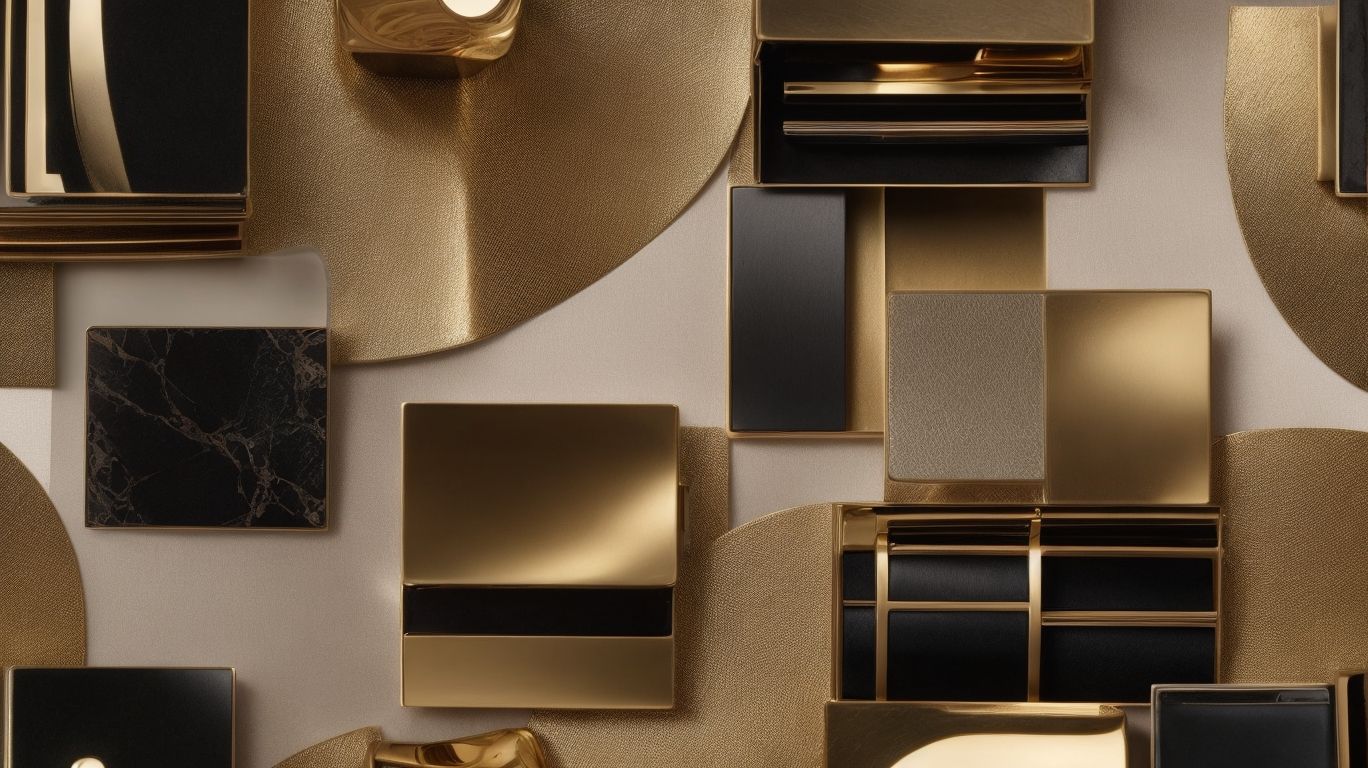
Are you tired of seeing the same old marble and gold in luxury design? Are you craving a new level of innovation and uniqueness? Look no further, because in this article, we will explore the exciting world of innovative materials in luxury design that goes beyond the traditional choices. Get ready to be amazed and inspired by the endless possibilities of these materials.
What Are Innovative Materials in Luxury Design?
What Are Innovative Materials in Luxury Design?
Innovative materials in luxury design encompass a range of cutting-edge options that go beyond traditional choices like marble and gold. These materials offer a combination of unique aesthetics, functionality, and sustainability. Some examples of innovative materials include:
- Carbon fiber: Renowned for its lightweight and high-strength properties, carbon fiber is utilized in luxury products such as high-end watches and sports cars.
- Bio-based materials: Made from renewable resources such as plant fibers or bioplastics, bio-based materials are gaining popularity in eco-conscious luxury design.
- Transparent ceramics: Offering a blend of elegance and durability, transparent ceramics are used in luxury watches and jewelry for their scratch-resistant and UV-resistant properties.
- Nanomaterials: With unique properties at the nanoscale, nanomaterials offer enhanced performance in luxury products like clothing, accessories, and electronics.
By embracing these innovative materials, luxury designers have the opportunity to create one-of-a-kind and sustainable products that cater to the evolving demands of consumers.
What Are the Advantages of Using Innovative Materials in Luxury Design?
When it comes to luxury design, materials like marble and gold have long been associated with opulence and sophistication. However, in recent years, there has been a shift towards using innovative materials in luxury design. In this section, we will explore the advantages of incorporating these new and unconventional materials into luxury design. From sustainability to cost-effectiveness, we will uncover how these materials offer unique benefits that go beyond the traditional notions of luxury.
1. Sustainability
When it comes to sustainability in luxury design, designers can take several steps to incorporate innovative materials:
- Evaluate the life cycle of materials, considering their environmental impact from production to disposal.
- Choose materials made from renewable resources, such as bamboo or bio-based materials.
- Opt for recycled materials, like plastics, to reduce waste and promote a circular economy.
- Consider the carbon footprint of materials and select options with lower emissions.
- Collaborate with material suppliers who prioritize sustainability and offer eco-friendly alternatives.
- Educate consumers about the benefits of sustainable materials and their positive impact on the environment.
2. Versatility
Versatility is a key advantage of utilizing innovative materials in luxury design. To fully leverage this versatility in their creations, designers can follow these steps:
- Research and explore a wide range of innovative materials available in the market.
- Identify the properties and characteristics of each material to determine its potential applications.
- Experiment with different combinations of materials to create unique and versatile designs.
- Collaborate with material suppliers to understand the full potential and limitations of each material.
- Stay updated with the latest trends and advancements in innovative materials to continuously push the boundaries of design versatility.
In fact, a renowned luxury furniture designer once incorporated a lightweight and flexible material into the construction of a chair, showcasing the potential of versatility in design. This material allowed the chair to easily transform and adapt to different seating positions, providing unparalleled comfort to its users.
3. Cost-effectiveness
To achieve cost-effectiveness in luxury design using innovative materials, designers can follow these steps:
- Research: Explore available innovative materials and compare their prices to traditional luxury materials.
- Cost analysis: Determine the total cost of using innovative materials, including procurement, production, and maintenance.
- Evaluate lifespan: Assess the durability and longevity of innovative materials to understand their long-term cost-effectiveness.
- Consider production efficiency: Analyze the manufacturing process and machinery required for working with innovative materials, factoring in any additional costs.
- Collaborate with suppliers: Engage in partnerships with material suppliers to negotiate pricing and explore cost-effective options.
- Optimize design: Design products that maximize the potential of innovative materials while minimizing waste and optimizing resource usage.
- Track market trends: Stay updated on emerging innovative materials and market trends to identify cost-effective options.
4. Durability
Durability plays a crucial role in the consideration of innovative materials within luxury design. These materials are specifically designed to withstand wear and tear, ensuring long-lasting quality and maintaining the value of luxury products. For instance, recycled plastics not only offer durability but also promote environmental friendliness. Bamboo is another durable option that adds a touch of natural elegance to designs. Bio-based materials, such as plant fibers, combine durability with sustainability. Additionally, smart fabrics, equipped with advanced technologies, provide durability while also offering functionalities such as self-cleaning or temperature regulation. The durability of these innovative materials is revolutionizing the luxury design industry, providing products that can withstand the test of time.
What Are Some Examples of Innovative Materials in Luxury Design?
Luxury design is no longer limited to traditional materials like marble and gold. With advancements in technology and a growing focus on sustainability, designers are incorporating innovative materials into their creations. In this section, we will explore some examples of these materials, including recycled plastics, bamboo, bio-based materials, and smart fabrics. Each of these materials brings its own unique properties and benefits to the world of luxury design, pushing the boundaries of what is possible in terms of both aesthetics and sustainability.
1. Recycled Plastics
Using recycled plastics in luxury design can be a sustainable and innovative choice. Here are some steps to incorporate recycled plastics into luxury designs:
- Research: Identify suppliers and manufacturers that offer high-quality recycled plastics suitable for luxury products.
- Design: Work with designers and engineers to create innovative and visually appealing designs that seamlessly incorporate recycled plastics.
- Testing: Ensure that the recycled plastics meet the required quality and durability standards through rigorous testing.
- Production: Collaborate with manufacturers to produce the luxury products using recycled plastics.
- Marketing: Highlight the eco-friendly aspect of incorporating recycled plastics in your luxury designs to appeal to environmentally conscious consumers.
By embracing recycled plastics, luxury designers can contribute to a greener future while still creating stunning and desirable products.
2. Bamboo
Bamboo is a versatile and sustainable material that offers numerous advantages in luxury design. When incorporating bamboo into your design projects, consider the following steps:
- Research: Learn about the different types of bamboo and their properties to determine the most suitable variety for your design.
- Sourcing: Find reputable suppliers that offer sustainable and ethically sourced bamboo materials.
- Processing: Ensure proper treatment and processing techniques are used to enhance the durability and longevity of bamboo materials.
- Design Integration: Explore various ways to incorporate this innovative material into your luxury designs, such as furniture, flooring, or decorative accents.
- Collaboration: Work with skilled craftsmen and artisans who specialize in working with bamboo to bring your design vision to life.
- Finishing: Apply appropriate finishes to protect and enhance the natural beauty of bamboo, such as eco-friendly varnishes or oils.
- Educate: Educate clients and consumers about the benefits of using bamboo in luxury design, including its sustainability, versatility, and unique aesthetic appeal.
3. Bio-based Materials
Bio-based materials are becoming increasingly popular in the luxury design industry due to their sustainable and eco-friendly nature. Designers can incorporate these materials into their creations by following these steps:
- Research: Start by exploring the various types of bio-based materials available, such as bioplastics, biofabrics, or biocomposites.
- Selection: Choose the appropriate bio-based material based on its properties, such as strength, flexibility, or texture, to ensure it meets the desired design goals.
- Collaboration: Work closely with suppliers and manufacturers who specialize in bio-based materials to ensure a reliable and consistent supply.
- Testing: Conduct thorough testing to assess the performance, durability, and safety of the chosen bio-based material in real-world applications.
- Integration: Seamlessly integrate the bio-based material into the design, considering factors like aesthetics, functionality, and feasibility.
- Educate: Educate consumers about the benefits of bio-based materials, emphasizing their positive environmental impact and sustainability.
By following these steps, designers can successfully incorporate bio-based materials into their luxury designs, contributing to a more sustainable and environmentally conscious industry.
4. Smart Fabrics
Smart fabrics are transforming the luxury design industry, bringing together technology and style in clothing, accessories, and home decor. These innovative fabrics offer advanced features such as built-in sensors, temperature regulation, and interactive capabilities. They not only enhance comfort, functionality, and aesthetics but also greatly appeal to the luxury market.
Examples of smart fabrics include:
- conductive textiles
- shape memory fabrics
- e-textiles
which are revolutionizing the industry by providing new avenues for creativity and innovation, promoting sustainable production methods, and meeting the evolving demands of consumers. Despite challenges such as limited availability and higher costs, designers can overcome these obstacles through collaboration with material suppliers, embracing new technologies, and educating consumers about the benefits of smart fabrics.
A well-known luxury fashion brand joined forces with a smart fabric manufacturer to create a collection featuring smart textiles. The highlight of the collection was a dress embedded with sensors that changed color based on the wearer’s body temperature and mood, captivating fashion and technology enthusiasts alike. This successful collaboration opened doors for further exploration and experimentation with smart fabrics in the luxury design industry, demonstrating the limitless possibilities and potential for innovation.
How Are These Materials Transforming the Luxury Design Industry?
The luxury design industry is constantly evolving and seeking new ways to stand out and appeal to consumers. In recent years, there has been a surge in the use of innovative materials that go beyond the traditional choices of marble and gold. In this section, we will explore how these materials are transforming the industry in three key ways: reducing environmental impact, encouraging creativity and innovation, and catering to changing consumer preferences.
1. Reducing Environmental Impact
To minimize the environmental impact of luxury design, designers can take several steps:
- Utilize sustainable and eco-friendly materials such as recycled plastics and bio-based materials.
- Incorporate energy-efficient manufacturing processes and strive to reduce waste.
- Embrace circular design principles and prioritize product longevity and recyclability.
- Source materials from ethical suppliers and support fair trade practices.
Fact: By embracing sustainable practices, the luxury design industry can play a significant role in conserving natural resources and protecting the planet for future generations.
2. Encouraging Creativity and Innovation
Encouraging creativity and innovation in luxury design can be achieved by following a series of steps:
- Embrace unconventional materials and experiment with their applications.
- Collaborate with artists, designers, and architects to bring fresh perspectives.
- Constantly explore new technologies to push boundaries and create unique designs.
- Keep up with emerging trends and consumer preferences to stay relevant.
Fact: The use of innovative materials in luxury design has led to the creation of furniture made from recycled ocean plastic, blending sustainability with high-end aesthetics.
3. Catering to Changing Consumer Preferences
Catering to the ever-changing preferences of consumers is crucial in the luxury design industry. To meet these evolving demands, designers can take the following steps:
- Conduct market research: Stay attuned to consumer trends and preferences by conducting thorough market research.
- Listen to customer feedback: Actively engage with customers to understand their needs and desires.
- Offer customization options: Provide consumers with the ability to personalize luxury designs and cater to their individual preferences.
- Embrace sustainability: Incorporate eco-friendly and sustainable materials and practices to appeal to environmentally conscious consumers.
- Stay updated with technology: Integrate technological advancements, such as smart features, into luxury designs to cater to tech-savvy consumers.
What Are the Challenges of Using Innovative Materials in Luxury Design?
As the world of luxury design continues to evolve, so do the materials used to create lavish and awe-inspiring pieces. While marble and gold have long been associated with luxury, designers are now turning to more innovative and unconventional materials. However, with these new materials come unique challenges that must be navigated. In this section, we will discuss the top challenges that designers face when incorporating innovative materials into luxury designs, such as limited availability, higher costs, and potential quality issues.
1. Limited Availability
The limited availability of innovative materials in luxury design can be a challenge for designers, but there are ways to overcome this issue:
- Research: Conduct thorough research to identify suppliers or manufacturers that offer the desired innovative materials that may have limited availability.
- Networking: Build relationships and network with industry professionals, including material suppliers and other designers, to gain access to these limited materials.
- Collaboration: Collaborate with material suppliers to explore possibilities for producing the desired materials in larger quantities.
- Alternative materials: Identify alternative materials that can achieve a similar aesthetic or functionality if the desired innovative materials are not readily available.
- Customization: Work with suppliers to create custom versions of the limited materials, tailored specifically for the design project.
- Adaptability: Stay updated on new developments and emerging materials in the market to have more options when facing limited availability of materials.
2. Higher Costs
When incorporating innovative materials into luxury design, designers may encounter the challenge of higher costs. However, there are steps they can take to overcome this obstacle:
- Conduct thorough research and compare prices of different innovative materials.
- Explore cost-saving alternatives without compromising on quality.
- Consider bulk purchasing or partnering with other designers to negotiate better prices.
- Collaborate with material suppliers to find innovative ways to reduce costs.
- Optimize design processes to minimize material waste.
For example, a true story of a designer facing higher costs and successfully overcoming them could be about a renowned fashion designer who wanted to incorporate a sustainable and innovative material into their collection. Despite the initial deterrence of higher costs, through research and collaboration with material suppliers, they found a cost-effective solution that allowed them to use the innovative material without exceeding their budget. This decision not only benefited the designer financially but also gained them recognition for their commitment to sustainability.
3. Potential Quality Issues
When incorporating innovative materials into luxury design, it is important to address any potential quality issues that may arise. To mitigate these issues, designers can follow these steps:
- Conduct thorough research on the chosen materials to understand their properties and limitations.
- Test the materials extensively to ensure they meet the required standards for performance.
- Collaborate with experienced material suppliers who can provide guidance and support throughout the design process.
- Implement strict quality control measures during production to catch any potential issues early on.
- Regularly communicate with manufacturers and suppliers to address any quality concerns and make necessary adjustments.
By following these steps, designers can minimize the potential quality issues associated with using innovative materials and ensure the final products meet the desired standards of luxury design.
How Can Designers Overcome These Challenges?
As the luxury design industry evolves, so do the challenges faced by designers. With the growing demand for unique and sustainable materials, designers are tasked with finding innovative solutions that go beyond traditional options like marble and gold. In this section, we will discuss how designers can overcome these challenges by collaborating with material suppliers, embracing new technologies, and educating consumers about the benefits of using innovative materials in their designs. These strategies will help designers stay ahead of the curve and create truly exceptional and sustainable luxury designs.
1. Collaboration with Material Suppliers
Collaborating with material suppliers is essential when incorporating innovative materials into luxury design. To effectively collaborate with suppliers, follow these steps:
- Research: Identify reputable suppliers who specialize in innovative materials.
- Communication: Establish open lines of communication with suppliers to discuss design requirements and material options.
- Collaborative Design: Work closely with suppliers to co-create designs that showcase the unique properties of the innovative materials.
- Testing and Evaluation: Conduct thorough testing and evaluation of the materials to ensure they meet quality standards.
- Feedback and Iteration: Provide feedback to suppliers on the performance and suitability of the materials, facilitating improvements if necessary.
- Timely Delivery: Coordinate with suppliers to ensure timely delivery of the materials for the design process.
- Long-term Partnerships: Foster long-term partnerships with reliable suppliers to leverage their expertise and access to the latest innovative materials.
2. Embracing New Technologies
Incorporating innovative materials into luxury design requires embracing new technologies. Here are some steps designers can take:
- Stay updated: Keep up-to-date with emerging technologies in the design industry.
- Research and experimentation: Explore the application of new technologies in luxury design and experiment with various materials.
- Collaborate with experts: Partner with engineers, scientists, and material suppliers to understand the potential and limitations of new technologies.
- Integrate technology seamlessly: Ensure that the use of new materials and technologies enhances the overall aesthetic of the design.
- Educate consumers: Inform consumers about the benefits and value of using innovative materials and technologies in luxury design.
By embracing new technologies, designers can unlock endless possibilities and create truly unique and sustainable luxury designs.
3. Educating Consumers about the Benefits of Innovative Materials
Educating consumers about the advantages of innovative materials is essential in the luxury design industry. By emphasizing the sustainability, versatility, and cost-effectiveness of these materials, designers can raise awareness and influence consumer decisions. They can provide examples such as recycled plastics, bamboo, bio-based materials, and smart fabrics to showcase the potential of these materials. Overcoming challenges, such as limited availability and higher costs, requires collaboration with material suppliers and embracing new technologies. Through education and information, consumers can gain a better understanding of the value and positive impact of using innovative materials in luxury design.






